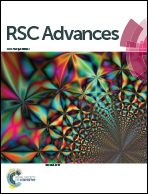Single-stranded structure of alginate and its conformation evolvement after an interaction with calcium ions as revealed by electron microscopy
Abstract
The single-stranded structure of alginate and its conformations of the egg-box junctions after binding with Ca2+ ions were visualized for the first time by electron microscopy. The exaggerated egg-box junctions of the calcium alginate assembly consisted of four repeating units, each of which comprised three Ca2+-linked G-block pairs and one M-block pair.


 Please wait while we load your content...
Please wait while we load your content...